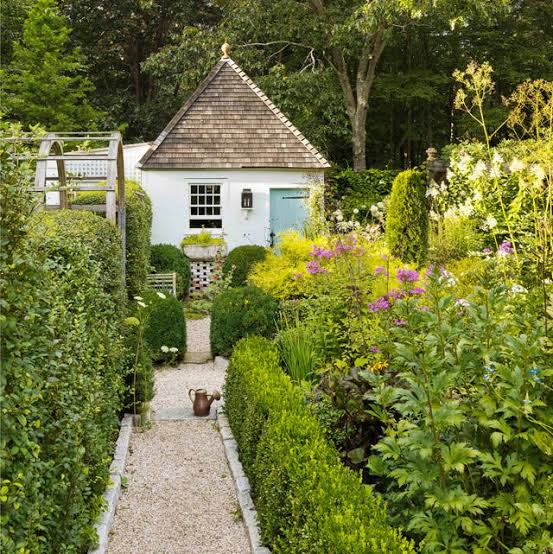There’s something timeless about a cottage garden —a charming, slWhat makes them so appealing is their versatility. Whether you prefer the classic look of traditional Engliswith rosmodern, creative twists like ornamental grasses and edible plants, the cottage garden welcomes all styles. Truly, classic or creative: cottage garden works both ways!This guide will walk you through the history, design principles, plant choices, and practical tips for building your own dream cottage garden—whether you lean toward timeless tradition or contemporary creativity.🌿The Origins of the Cottage GardenThe cottage garden traces its roots back to 16th-century England, where working families grew plants close to their homes for food, medicine, and beauty. These gardens were practical yet picturesque, with vegetables, herbs, and flowers mingling together.Over time, the cottage garden evolved into a romantic style loved worldwide, known for:Dense planting – no bare soil, everything overflowing.Casual design – informal paths and borders.Functional beauty – edible herbs alongside decorative blooms.Today, cottage gardens continue to inspire gardeners who want lush, inviting spaces full of personality.🌸The Classic Cottage Garden StyleWhen people imagine a cottage garden, they often picture the traditional English version :Roses and Honeysuckle climbing up trellises or archways.Lavender borders filling the air with fragrance.Foxgloves, Delphiniums, and Hollyhocks standing tall at the back of beds.Mix of herbs and edibles like thyme, mint, and strawberries among flowers.Meandering paths lined with stone, gravel, or brick.This style embraces romance and nostalgia , evoking storybook charm. The planting is layered, overflowing, and often centered around a quaint cottage or small structure.🌼Creative Modern Twists on Cottage GardensIf traditional isn’t your style, don’t worry—the cottage garden can also be creative, bold, and unexpected .Contemporary Plant Choices – Add ornamental succulents, succulents, or even tropical plants.Edible Landscaping – Blend tomatoes, kale, or blueberries among flowers.Wildflower Influence – Create a meadow-like effect with native pollinator-friendly plants.Color Play – Go beyond pastel shades to include bright oranges, deep purples, or dramatic contrasts.Minimalist Hardscaping – Instead of rustic stone paths, try clean gravel lines or modern planters for a fresh twist.This modern take is ideal if you want a garden that reflects your personality while keeping the lush, layered spirit of a cottage garden.🌱Key Principles for Both Classic and Creative StylesNo matter which way you lean— classic or creative —some design principles unite all cottage gardens:1. Plant GenerouslyCrowd your beds with perennials, annuals, and herbs. The beauty lies in abundance.2. Mix and MatchBlend heights, textures, and colors for a layered look.3. Include EdiblesEven in creative gardens, edible herbs and vegetables add authenticity and function.4. Keep it CasualPaths, borders, and planting layouts should feel natural rather than rigid.5. Invite WildlifeChoose pollinator-friendly plants to attract bees, butterflies, and birds.🌺 Choosing Plants for Your Cottage GardenHere are plant suggestions for each style:Classic ChoicesRosesLavenderFoxglovesDelphiniumsSweet peasGeraniumsHollyhocksCreative ChoicesOrnamental grassesConeflowers (Echinacea)Succulents in sunny spotsSunflowers for bold heightVegetables like rainbow chard or kaleNative wildflowers for low-maintenance charm🛠️ Practical Tips for Building Your Cottage GardenStart Small – Focus on one border or section, then expand.Layer Wisely – Tall plants at the back, medium in the middle, trailing or small at the front.Use Vertical Space – Trellises, arches, and fences are perfect for climbers.Encourage Self-Seeding – Let plants like sweet peas or poppies reseed naturally for a lived-in feel.Think Year-Round – Mix plants for spring blossoms, summer color, autumn foliage, and even winter interest.🌟 Why Cottage Gardens Work Both WaysThe real magic of a cottage garden is its adaptability . Unlike more rigid garden designs, the cottage style allows you to:Express your personality.Adapt to your climate and growing conditions.Blend old-world charm with modern creativity.Whether you dream of a storybook English cottage look or a bold, inventive garden , the same principles apply—layered planting, casual layouts, and an abundance of life.ConclusionWhen it comes to creating a lush, beautiful garden, you don’t have to choose between tradition and innovation. Classic or creative: cottage garden works both ways! Whether you fall in love with roses climbing over a stone wall or a playful mix of wildflowers and edibles, the cottage garden offers endless opportunities for expression.So, roll up your sleeves, choose your plants, and let your imagination guide you. With a cottage garden, the rules are simple: plant abundantly, blend beauty with function, and embrace the joy of a space that feels alive and uniquely yours.SEO ExtrasSEO Title: 🥘 Classic or Creative: Cottage Garden Works Both Ways!Meta Description: Discover how to design a cottage garden that fits your style. Whether classic or creative, cottage gardens offer lush planting, charm, and personality.Keyword List:cottage gardenclassic cottage gardencreative cottage garden ideasEnglish cottage garden plantsmodern cottage garden stylecottage garden design tipsHow to plant a cottage garden

